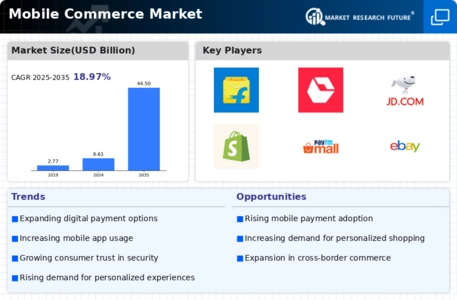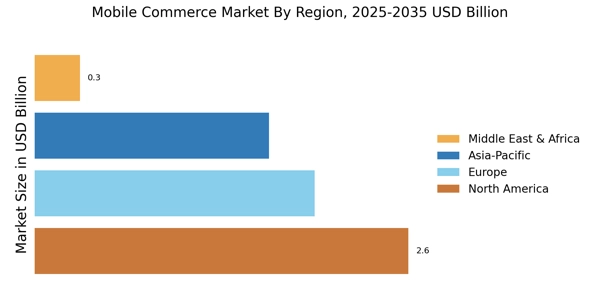Rise of Social Commerce
The emergence of social commerce is reshaping the Mobile Commerce Market. Social media platforms are increasingly integrating shopping features, allowing users to purchase products directly through their feeds. As of October 2025, it is estimated that social commerce sales will reach $600 billion, highlighting the potential of social media as a sales channel. This trend is particularly pronounced among younger consumers, who are more inclined to discover and buy products through social networks. Brands are leveraging influencer partnerships and targeted advertising to engage with their audience, driving traffic to their mobile commerce sites. The Mobile Commerce Market is thus witnessing a convergence of social media and e-commerce, creating new opportunities for businesses to connect with consumers in innovative ways. This integration not only enhances the shopping experience but also fosters brand loyalty among users.
Growing Demand for Convenience
The increasing demand for convenience is a fundamental driver of the Mobile Commerce Market. Consumers today prioritize ease of access and quick transactions, leading to a surge in mobile shopping applications and services. As of October 2025, studies indicate that nearly 70% of consumers prefer shopping via mobile devices due to the convenience it offers. This trend has prompted retailers to enhance their mobile platforms, ensuring that they provide user-friendly interfaces and efficient checkout processes. The Mobile Commerce Market is adapting to these consumer preferences by incorporating features such as one-click purchasing and personalized recommendations. As convenience continues to be a key factor in consumer decision-making, businesses that prioritize mobile optimization are likely to gain a competitive edge in the marketplace.
Increased Smartphone Penetration
The proliferation of smartphones has been a pivotal driver in the Mobile Commerce Market. As of October 2025, it is estimated that over 80% of the population in developed regions owns a smartphone, facilitating seamless access to mobile commerce platforms. This widespread adoption enables consumers to shop, pay, and engage with brands directly from their devices. The convenience offered by mobile applications and websites has led to a notable increase in mobile transactions, which are projected to account for over 50% of total e-commerce sales. Consequently, businesses are increasingly optimizing their platforms for mobile use, recognizing the necessity to cater to this growing demographic. The Mobile Commerce Market is thus experiencing a transformation, as companies strive to enhance user experience and capitalize on the expanding smartphone user base.
Advancements in Payment Technologies
Innovations in payment technologies are significantly influencing the Mobile Commerce Market. The introduction of contactless payment systems, such as NFC and QR codes, has streamlined the purchasing process, making it more efficient and secure. As of October 2025, mobile payment transactions are expected to surpass $1 trillion, reflecting a growing consumer preference for quick and hassle-free payment methods. Additionally, the integration of biometric authentication, such as fingerprint and facial recognition, enhances security, thereby increasing consumer confidence in mobile transactions. This shift towards advanced payment solutions is compelling retailers to adopt mobile-friendly payment systems, which in turn drives growth in the Mobile Commerce Market. The ongoing evolution of payment technologies suggests a future where mobile transactions become the norm, further embedding mobile commerce into everyday consumer behavior.
Integration of Artificial Intelligence
The integration of artificial intelligence (AI) is transforming the Mobile Commerce Market by enhancing personalization and customer engagement. AI technologies enable businesses to analyze consumer behavior and preferences, allowing for tailored marketing strategies and product recommendations. As of October 2025, it is projected that AI-driven solutions will account for a substantial portion of mobile commerce transactions, as they facilitate a more personalized shopping experience. This capability not only improves customer satisfaction but also drives sales conversions. Retailers are increasingly adopting AI chatbots and virtual assistants to provide real-time support, further enriching the consumer experience. The Mobile Commerce Market is thus evolving, as companies leverage AI to create more engaging and relevant interactions with their customers, ultimately fostering loyalty and repeat business.


















Leave a Comment